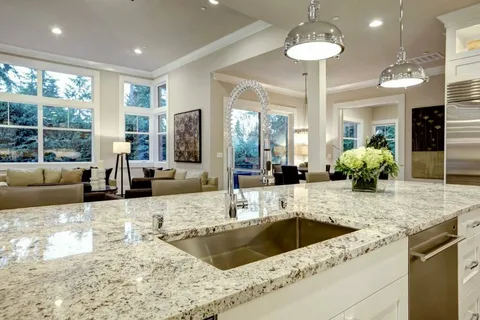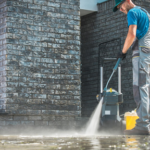Granite countertops have been one of the most popular choices for kitchens and bathrooms for decades. Known for their natural beauty and durability, granite remains a timeless option that adds elegance and value to any home. If you’re considering granite for your next project, this guide will walk you through everything you need to know—from what granite is, to its pros and cons, cost factors, styles, and maintenance tips.
What Are Granite Countertops?
Granite is a natural stone formed deep within the earth, made up of minerals like quartz, feldspar, and mica. Each slab is unique, with patterns and colors that can’t be duplicated. This natural variation is what gives granite countertops their distinctive charm and luxurious appeal. Unlike engineered materials, granite is cut directly from quarries and polished into slabs, which are then customized to fit your kitchen or bathroom, making them a perfect choice for custom stone kitchen surfaces.
The Advantages and Disadvantages of Granite Countertops
Granite countertops come with many benefits, but it’s important to consider both sides before making your decision.
Pros of Granite Countertops
- Durability: Granite is extremely hard and resistant to scratches.
- Heat Resistance: Hot pots and pans won’t easily damage it.
- Unique Beauty: Every slab is different, giving your kitchen a custom look.
- Adds Value: Granite is a premium material that increases home resale value.
- Variety: Available in countless colors and natural patterns.
Cons of Granite Countertops
- Maintenance: Needs sealing to protect against stains.
- Cost: Can be more expensive than laminate or tile.
- Heavy Material: Requires strong cabinet support.
- Seams: Large kitchens may have visible seams.
Granite Countertops vs. Other Materials
When deciding on granite, it helps to compare it to other popular choices.
- Granite vs. Quartz – Quartz is non-porous and low maintenance, while granite is natural and unique but needs sealing.
- Granite vs. Marble – Marble has a softer, more elegant look but stains and scratches easily. Granite is tougher and easier to maintain.
- Granite vs. Laminate – Laminate is budget-friendly but doesn’t last as long. Granite is pricier but adds more value and durability.
Popular Granite Countertop Colors and Patterns
Granite is available in a wide range of styles, from light and airy to bold and dramatic. Some trending options include:
- Black Galaxy – Sleek black with shimmering gold flecks.
- White Ice – Crisp white background with subtle gray veining.
- Ubatuba – Deep green with hints of black and gold.
- Blue Pearl – Striking blue tones with silver highlights.
- Tan Brown – Warm brown shades with black and red accents.
What Affects Granite Countertops Cost?
The cost of granite countertops depends on several key factors. Exotic colors and rare patterns usually come at a higher price, while thicker slabs also add to the cost but provide extra strength and durability. The edge style you choose, such as ogee or waterfall, can further increase the price, and the complexity of installation especially in larger kitchens or with custom cuts—will also affect the overall budget. In addition, the origin of the stone plays a role, as imported granite often carries higher shipping expenses. If you’d like to explore pricing in more detail, you can learn more about granite countertops cost in our complete breakdown.
Tips for Cleaning and Maintaining Granite Countertops
With the right care, granite countertops can truly last a lifetime. Daily cleaning with warm water and mild soap is usually enough to keep the surface looking fresh. Harsh cleaners such as bleach or ammonia should be avoided, as they can damage the stone. To maintain protection against stains, resealing every one to two years is recommended. It’s also important to wipe up spills quickly, especially if they involve wine, oil, or acidic juices. Using cutting boards will help prevent scratches, while placing trivets under hot cookware will protect the surface from thermal shock.
Things to Consider Before Buying Granite Countertops
Before making your final decision, keep these points in mind:
- Budget – Decide how much you’re willing to spend, including installation.
- Kitchen Style – Choose a color and pattern that complements your cabinets and flooring.
- Maintenance Needs – Be prepared to reseal regularly.
- Installer Experience – Always hire a professional with granite installation expertise.
- Sustainability – Some granite suppliers focus on eco-friendly quarrying and shipping.
Conclusion
Granite countertops continue to be a favorite for homeowners who want a natural, durable, and elegant surface. While they may require a higher investment and some upkeep, their timeless beauty and lasting performance make them worth it. From sleek modern kitchens to traditional spaces, granite can elevate the look of any home. If you’re ready to transform your kitchen or bathroom, granite countertops might just be the perfect choice.


